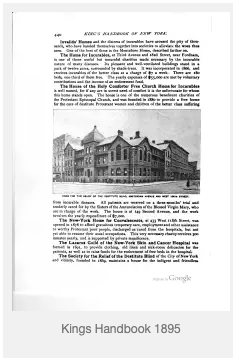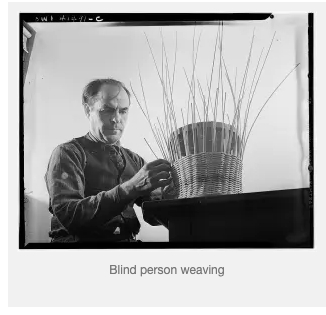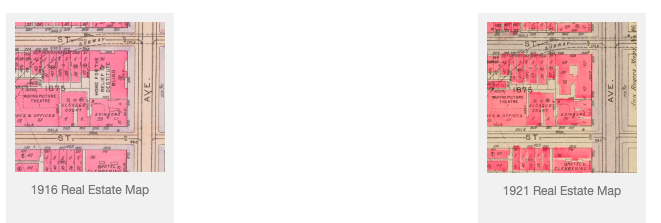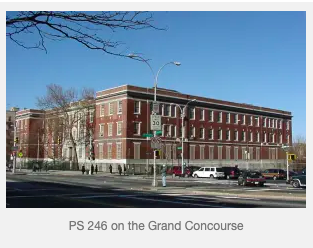|
This is another post in a series by Pam Tice, member of the Planning Committee of the Bloomingdale Neighborhood History Group, covering buildings that no longer exist in our neighborhood. From the mid-1880s, this beautiful red brick building stood at the corner of Amsterdam Avenue and 104th Street for more than thirty years, housing blind men and women in The Home for the Relief of Destitute Blind. This photograph was taken in 1898 by Robert Louis Bracklow (1849-1919), a New York stationer who was also a talented amateur photographer. The photo gives us a sense of what Amsterdam Avenue looked like with its trolley tracks, fancy street lights, and telephone lines above the street. Mr. Bracklow’s extensive collection is posted HERE by the New-York Historical Society. (Warning: there are more than 2000 photos to look at!) The Society of the same name that built the building had been founded in 1868 by an Episcopal minister, the Reverend Eastburn Benjamin. An 1856 graduate of the Theological Seminary of Virginia, he served as Assistant Minister of St. Ann’s Church for Deaf Mutes in New York from 1864 to 1868. The Rector of that church was Reverend Thomas Gallaudet, whose son later founded Gallaudet University in Washington, D.C. This experience may have given the Reverend Benjamin his interest in establishing an institution to serve the disabled. New York City had established a residential school, the Institute for the Blind, to educate blind children in the 1830s, possibly modeled on the Perkins Institute for the Blind in Boston. New York’s effort to educate blind children had been spurred on by a philanthropic physician who had removed three blind orphans from a public institution, housed them in a widow’s home, and proceeded to teach them using the materials of raised letters on a page. Braille wasn’t devised until the middle of the century. The Society for the Relief of the Destitute Blind was an effort to deal with the adult blind, whether schooled or not, to provide support and a means to earn a living. At a time when the gulf between abled and disabled people was so great, the fact that blind people could be educated must have been an important step in recognizing them as “worthy” recipients of aid. Reverend Benjamin’s impetus to form a new charity to deal with a specific social problem came at a time in New York City’s history when industrialization and immigration created an increasing number of poor persons. Although there was some government aid, support came primarily from church-based charities. Reverend Benjamin—perhaps through his experience at St. Ann’s in Brooklyn—appears to have been skilled enough to form a charitable effort that succeeded. Like today’s non-profits, he had to create a funding operation that would sustain the organization. In May 1868, the Reverend Eastburn Benjamin founded a Manhattan church to serve the blind: the Free Church of the Holy Light. Early advertisements for its Sunday services at the 37th Regiment Armory at Broadway and 37th Street were posted in the New York Herald. In January, 1869, an article about a Home for the Blind appeared in the New York Herald. The article notes that There is in this city a very large number of persons who are affected with either total or partial blindness, who are thereby precluded from obtaining a livelihood by any other means than at the hand of charity. Many of them eke out a beggarly existence by peddling shoe strings and other trifles in the market places, or with placards on their breasts pitifully invoke the attention of passersby with their monotone, “Please help the blind.” All the State asylums for the blind reject applicants who are upward of thirty years of age, and for these there is no provision. They shrink from entering the county poorhouse; and this class of adult blind is very large, hence a great deal of suffering prevails among them, living in the most noisome cellars and garrets and feeding upon almost any refuse food. They do not need a church specifically devoted to them for worship, but they require physical assistance, and with a view of rendering some aid Rev. Eastburn Benjamin established in April last the Church of the Holy Light, having for its wardens Sylvester R. Comstock, president of the Citizen’s Bank, and Mr. George W.T. Lord and a number of eminent gentlemen as vestrymen. The Church has assumed as its mission the adult blind of New York and vicinity, and Dr. Benjamin leased a house at Second Avenue and Fifty-Seventh Street for three years, at $3,500 per year, as a Home for the blind, and it has already upwards of twent-five inmates. Religious belief is no test of admission, and it is intended to introduce some branches of labor at which the inmates can work. The article finishes with a note on where contributions can be made, to Mr. Lord at 199 Second Avenue, and to Dr. Benjamin at 48 West 37th Street. As described in this news article, Reverend Benjamin was wise to get two prominent and wealthy New Yorkers involved: Mr. Comstock, a bank president; and Mr. Lord, of the Lord & Taylor retail business. There’s no evidence that Reverend Benjamin came from a moneyed family, nor did his wife Cornelia. When Mr. Comstock died in 1882, his obituary noted that the Reverend Gaudellet gave the burial service, so Reverend Benjamin may have recruited vestrymen from St. Ann’s Church for his charitable efforts for the adult blind. When Mr. Lord died in Paris in 1903, his obituary noted that he was a millionaire, the last son of Samuel Lord who had founded the store and left his sons in charge to return to England with his fortune to establish a 200 acre estate. One early listing shows the Home for the Destitute Blind at 437 Seventh Avenue. An 1871 New York Episcopal Diocese report notes that the church had established a Home for the Blind in a building at 567 Seventh Avenue where 24 blind people of both sexes were housed and cared for, and noting that there was no other institution like it in the City, so that, if rejected here, blind people would find themselves in the almshouse (then on Blackwell’s Island). The Reverend Eastburn Benjamin died in 1874, a young man only 38 years old. His Church of the Holy Light appears to have ended; the 1882 Episcopal Diocese report notes that it still existed but held no services. Both the Reverend Benjamin and his wife are buried in Green-Wood Cemetery in Brooklyn. The Benjamin Family grave at Greenwood Cemetery The Society for the Relief of the Destitute Blind settled into a brownstone at 219 West 14th Street, and was a going concern. An 1877 news article reported that the Home had a “workshop” in operation and was ready to receive orders for mattress repair, mattress making, and chair caning. The female inmates (the word used in the Victorian era for anyone living in such an institution) were able to do “plain sewing and fancy worsted and bead work of various descriptions.” The Home was described as having large and comfortable “sleeping apartments,” and visitors were allowed twice a week. Like other institutions, the Society gave weekly support to “outside” recipients, the term applied to those who did not live in their Home. In How The Other Half Lives (1890), Jacob A. Riis writes in his chapter on “Pauperism in the Tenements,” a description of the blind beggars of New York: The blind beggar alone is winked at in New York’s streets, because the authorities do not know what else to do with him. There is no provision for him anywhere after he is old enough to strike out for himself. The annual pittance of thirty or forty dollars which he received from the city serves to keep his landlord in good humor; for the rest his misfortune and his thin disguise of selling pencils on the street corners must provide. Until the city affords him some systematic way of earning his living by work (as Philadelphia has done, for instance) to banish him from the street would be tantamount to sentencing him to death by starvation. This piece describes the plight of the blind person, providing the charitable impulse that compelled the Protestant Episcopal New Yorkers (and others) who supported the work of the Society for the Relief of the Destitute Blind. Although the Board was entirely male, the Society soon had what the newspapers called “Lady Managers.” These were the women who took on the cause, holding sales of goods made by the women “inmates,” organizing theatrical evenings, and spending afternoons reading to the blind. Performing such charitable work was a necessary part of an upper-class woman’s role in the life of the City. As noted in an earlier essay about the Association for the Relief of Respectable Aged Indigent Women, this work outside the family structure gave women organizing skills that were applied to abolitionist work, and then suffrage work. One “Lady Manager” of special note in the 1880s was Mrs. August Belmont, the daughter of the famous Commander Perry who opened trading ports with Japan in 1857. Mrs. Belmont had married a German Jewish man who had converted to his wife’s Episcopal faith. Their son, the second August Belmont, was behind New York’s subway building in the early part of the 20th century. Both his father and mother died in the 1890s, leaving an estate of $10 million. One news article noted that Mrs. Belmont had left a legacy gift to the Home for the Destitute Blind, but did not state an amount. Another legacy gift was made by Eliza Osgood, the daughter of Cornelius Vanderbilt. In the mid-1880s, based on news reports, the “Lady Managers” of the Society for the Relief of the Destitute Blind stepped-up their activities. The Home at 219 West 14th Street was running out of space, and plans were made to build a bigger facility. A news article from 1884 noted that tickets for a theatrical event were available, listing the women who had them for sale, including Mrs. Belmont at 109 Fifth Avenue. The fundraising must have gone well, for in 1886, the new Home opened on the southwest corner of Tenth (later Amsterdam) Avenue and 104th Street. . Like the Association Residence for the Relief of Respectable Aged Indigent Women across the Avenue, the new Home took advantage of the Elevated train stop at 104th Street and Ninth Avenue. An elementary school had recently opened at the northeast corner of 104th Street and Tenth Avenue. An article in The Real Estate Record and Guide noted that two rows of houses had been erected on both the north and south sides of 104th Street between Tenth Avenue and The Boulevard (later, Broadway). On the south side, there were three-story brownstones with “drawing, sitting and reception rooms” on the first floor, a kitchen in the rear, a dining room in the basement, and, on the second floor, two bedrooms, each with a salon of its own, with “ample closet room and hot and cold water.” The third floor had four bedrooms, and the home had electric bells throughout for communicating with the servants. The New York Times 1886 description of the Home for the Relief of the Destitute Blind noted that the new home had space for 100 inmates. “It will be provided with fireproof staircases, bathrooms, a workshop and a chapel. The sexes will be domiciled in opposite sides of the building.” The New York Charities Directory described the Home as taking in “blind and friendless adults of both sexes of good moral character, free from infections or incurable diseases, irrespective of creed.” Here they would find “reasonable comforts, and have facilities for earning their livelihood, making mattresses, re-seating chairs, or doing all kinds of knitting work.” The architect for the Home was Frederick Charles Merry who was born in England but had grown up in New Jersey.* He’d also designed the Parish House at St. Michael’s Episcopal Church, a few blocks south on Amsterdam Avenue, which may have been the connection to the Episcopal leaders who chose him to design the Home. An 1893 listing of the Board of the Society listed men who were active in the Episcopal Church, and the Bishop of the New York Diocese, The Right Reverend Henry C. Potter, is listed as a “visitor” at the Home. The Board members were also professional men, including a banker, an attorney, a judge, and a commercial stationery merchant—not unlike today’s boards of New York’s non-profits. The 1900 Federal census listing for the Home shows a Matron with overall responsibility, and a Superintendent—also a woman—in charge of the workshop. There are at that time 33 males and 31 female inmates living there. Both men and women are a mix of people born in the United States, most from New York and New Jersey, and about a third are immigrants, with many from Germany and Ireland. Most of the inmates are in their 50s and 60s, although there was one 20 year old male, and two 20 year old women. The female jobs included a cook, a laundress, a seamstress, and five women designated “waitress,” which may refer to over-all maid jobs. Male jobs included an engineer and a watchman. In the 1910 Federal census, the Home had 98 inmates, demonstrating the need for a larger facility, a project the Board would undertake in just a few years. The overall management remains the same, with a Matron and an Assistant Superintendent, both women, but not the same two as in 1900. There are 16 workers, but now the female jobs are either “waitress,” “chambermaid,” or “servant.” There is a nurse, an engineer, a watchman, a cook, and a laundress. One man is labeled “Useful Man.” All of these staff members are immigrants, with the exception of the engineer and the two women supervising the Home. Between this 1910 census showing the Home at full capacity and the fall of 1916, the Society for the Destitute Blind built a new Home in the Bronx. The Society purchased about twenty lots bounded by the Grand Concourse, Kingsbridge Road, Croton Avenue and 193rd Street. The red-brick somewhat Colonial structure was designed by architects M.L. and H.G. Emery. Newspapers reported that the Society would spend $400,000 to build the new facility. The expected opening was to be in the spring of 1917. Not long after the old Home emptied out, the property was sold and the building taken down. Thanks to my two colleagues on the Planning Committee of the Bloomingdale Neighborhood History Group, Gil Tauber and Jim Mackin, we know that a building permit was issued in 1919 for the structure that was built in 1921 and still with us today. The Home for the Destitute Blind operated for many years at its Bronx location, which became 2641 Grand Concourse. In 1969, the Society for the Destitute Blind merged with the New York Infirmary, whose origins were Elizabeth Blackwell’s Infirmary for Destitute Women and Children. That institution became the Beekman Downtown Hospital, and today operates as New York-Presbyterian Downtown Hospital. One contemporary directory has a listing for the Society for the Destitute Blind at 500 Greenwich Street, but that location houses a program called “Visions,” which provides services for the blind and visually impaired at various locations in the New York City area. Today, the Society’s building on the Grand Concourse is the home of Public School 246, the Poe School. *Thanks to Jim Mackin of the BNHG Planning Committee for finding Mr. Merry.
Sources The New York Times archive, online Newspaper archive at www.genealogybank.com New York Episcopal Diocese reports, found online Federal census online at www.ancestry.com Real Estate Record and Guide online at Columbia University.
0 Comments
Leave a Reply. |





